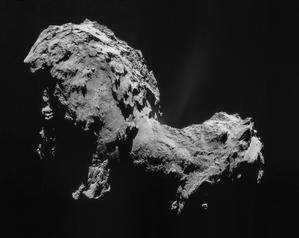Glossary term: Comet Nucleus
Description: A comet nucleus is the core of a comet. This is a solid object, similar to a dirty snowball, made with ice and rocky, dusty particles. Far from the Sun the nucleus is the sole component of the comet. Closer to the Sun a comet's nucleus is heated due to sunlight. This causes the surface ice to sublimate. The sublimated ice and the dust embedded in it are ejected and surround the nucleus as a coma with a tail pointing away from the Sun.
Related Terms:
See this term in other languages
Term and definition status: This term and its definition have been approved by a research astronomer and a teacher
The OAE Multilingual Glossary is a project of the IAU Office of Astronomy for Education (OAE) in collaboration with the IAU Office of Astronomy Outreach (OAO). The terms and definitions were chosen, written and reviewed by a collective effort from the OAE, the OAE Centers and Nodes, the OAE National Astronomy Education Coordinators (NAECs) and other volunteers. You can find a full list of credits here. All glossary terms and their definitions are released under a Creative Commons CC BY-4.0 license and should be credited to "IAU OAE".
If you notice a factual error in this glossary definition then please get in touch.
Related Media
Comet 67P/Churyumov-Gerasimenko
Credit: ESA/Rosetta/NAVCAM credit link
License: CC-BY-SA-3.0-IGO Creative Commons Attribution-ShareAlike 3.0 IGO icons









